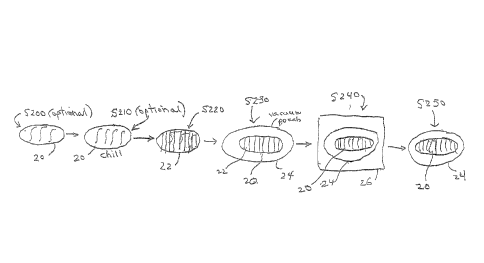Une partie des informations de ce site Web a été fournie par des sources externes. Le gouvernement du Canada n'assume aucune responsabilité concernant la précision, l'actualité ou la fiabilité des informations fournies par les sources externes. Les utilisateurs qui désirent employer cette information devraient consulter directement la source des informations. Le contenu fourni par les sources externes n'est pas assujetti aux exigences sur les langues officielles, la protection des renseignements personnels et l'accessibilité.
L'apparition de différences dans le texte et l'image des Revendications et de l'Abrégé dépend du moment auquel le document est publié. Les textes des Revendications et de l'Abrégé sont affichés :
| (12) Brevet: | (11) CA 2814760 |
|---|---|
| (54) Titre français: | PROCEDE POUR LE TRAITEMENT DE PRODUIT A BASE DE PROTEINES ANIMALES SOUS FORME CUITE EN TRANCHES |
| (54) Titre anglais: | A PROCESS FOR PROCESSING ANIMAL PROTEIN PRODUCT INTO COOKED, SLICED FORM |
| Statut: | Octroyé |
| (51) Classification internationale des brevets (CIB): |
|
|---|---|
| (72) Inventeurs : |
|
| (73) Titulaires : |
|
| (71) Demandeurs : |
|
| (74) Agent: | NORTON ROSE FULBRIGHT CANADA LLP/S.E.N.C.R.L., S.R.L. |
| (74) Co-agent: | |
| (45) Délivré: | 2018-11-27 |
| (86) Date de dépôt PCT: | 2011-10-06 |
| (87) Mise à la disponibilité du public: | 2012-05-03 |
| Requête d'examen: | 2016-10-04 |
| Licence disponible: | S.O. |
| (25) Langue des documents déposés: | Anglais |
| Traité de coopération en matière de brevets (PCT): | Oui |
|---|---|
| (86) Numéro de la demande PCT: | PCT/US2011/055008 |
| (87) Numéro de publication internationale PCT: | WO2012/057979 |
| (85) Entrée nationale: | 2013-04-15 |
| (30) Données de priorité de la demande: | ||||||
|---|---|---|---|---|---|---|
|
La présente invention concerne un procédé pour le traitement de produit à base de protéines animales comprenant la découpe en tranches d'une pièce sensiblement crue du produit, l'emballage sous vide du produit cru en tranches dans un sachet avec les tranches en empilage serré, la cuisson du produit emballé sous vide jusqu'à au moins sa température de pasteurisation à l'état emballé sous vide dans le sachet, et la réfrigération ou la congélation du produit pasteurisé toujours emballé sous vide dans le sachet.
A process for processing animal protein product involves cutting a substantially raw piece of the product into slices, vacuum sealing the sliced raw product in a pouch with the slices stacked tightly together, cooking the vacuum sealed product to at least its pasteurization temperature while vacuum sealed within the pouch, and refrigerating or freezing the pasteurized product still sealed in the pouch.
Note : Les revendications sont présentées dans la langue officielle dans laquelle elles ont été soumises.
Note : Les descriptions sont présentées dans la langue officielle dans laquelle elles ont été soumises.

Pour une meilleure compréhension de l'état de la demande ou brevet qui figure sur cette page, la rubrique Mise en garde , et les descriptions de Brevet , États administratifs , Taxes périodiques et Historique des paiements devraient être consultées.
| Titre | Date |
|---|---|
| Date de délivrance prévu | 2018-11-27 |
| (86) Date de dépôt PCT | 2011-10-06 |
| (87) Date de publication PCT | 2012-05-03 |
| (85) Entrée nationale | 2013-04-15 |
| Requête d'examen | 2016-10-04 |
| (45) Délivré | 2018-11-27 |
Il n'y a pas d'historique d'abandonnement
Dernier paiement au montant de 263,14 $ a été reçu le 2023-07-14
Montants des taxes pour le maintien en état à venir
| Description | Date | Montant |
|---|---|---|
| Prochain paiement si taxe générale | 2024-10-07 | 347,00 $ |
| Prochain paiement si taxe applicable aux petites entités | 2024-10-07 | 125,00 $ |
Avis : Si le paiement en totalité n'a pas été reçu au plus tard à la date indiquée, une taxe supplémentaire peut être imposée, soit une des taxes suivantes :
Les taxes sur les brevets sont ajustées au 1er janvier de chaque année. Les montants ci-dessus sont les montants actuels s'ils sont reçus au plus tard le 31 décembre de l'année en cours.
Veuillez vous référer à la page web des
taxes sur les brevets
de l'OPIC pour voir tous les montants actuels des taxes.
Les titulaires actuels et antérieures au dossier sont affichés en ordre alphabétique.
| Titulaires actuels au dossier |
|---|
| CUISINE SOLUTIONS, INC. |
| Titulaires antérieures au dossier |
|---|
| S.O. |